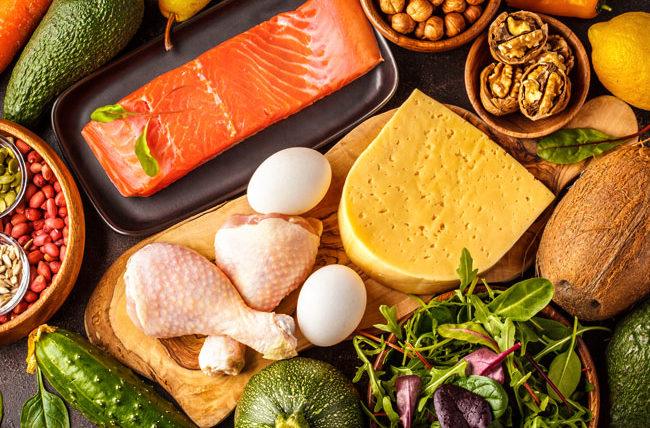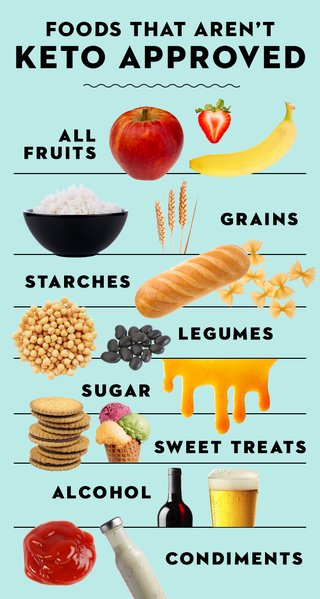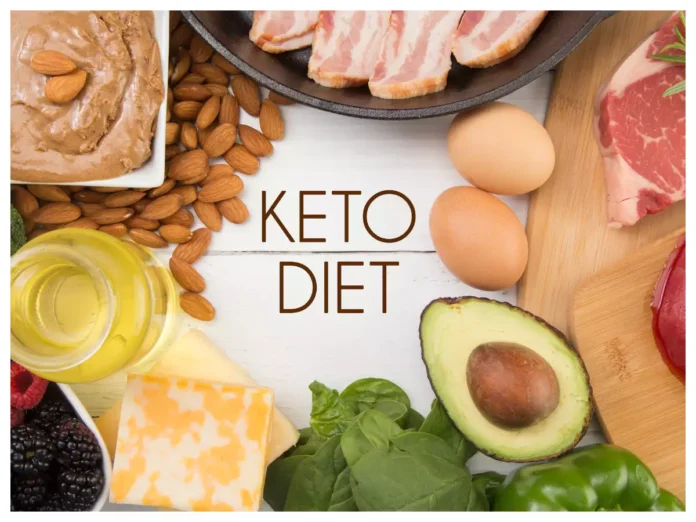What we commonly assume about the keto diet is that it is only related to weight loss.
Yes, it deals with obesity, but it has a prime role in a healthy life and curing many diseases.
What Is Keto Diet?
The Keto diet is a low carbohydrate diet with high fat intake. Daily calorie requirement is fulfilled through fat, not with carbohydrates.
It resembles the Atkins diet and many other low-carb diet plans, but the main difference between the ketogenic diet and other diet plans is the energy source.
Ketogenic diet drive energy from fats, while other low-carb diets gain energy from high protein intake.
The Keto diet became successful in the 19th century for treating epilepsy in children who are unresponsive to other treatments.
Moreover, it is also used to treat cancer, diabetes, heart disease, and Alzheimer’s.
In 1970 when the weight loss due to the Atkins diet plan gained popularity, the ketogenic diet also became famous because of its effective weight loss strategy.

Working Principle Of Ketogenic Diet
What is the primary source of energy for our body and brain?
It is glucose that comes from carbohydrates. In the keto diet, we cut glucose as a source of energy.
In the ketogenic diet, we intake a less carbohydrate diet, so our body responds against it. First, our body tries to utilize all the stored glucose, but after complete exhaustion, it shifts toward ketosis.
What Is Ketosis?
Ketosis is a metabolic state in which the fuel for energy comes from fat in a low carbohydrate diet.
Our brain requires 120g of glucose daily as it cannot store it, so when there is no glucose, our liver uses fats and converts them into ketone bodies.
These ketone bodies are then used as an energy source for the brain and body.
The ketogenic diet is an easy way to enter the ketosis state. In normal conditions, it occurs during fasting and sleep hours.
Checkpoints
- During ketosis, examine your protein intake because protein can also be converted into glucose by our body, and many inhibit ketosis.
- Intermittent fasting also helps you to enter the ketosis state.
- Blood and urine tests help determine the ketone bodies inside the body, an easy way to check the progress of ketosis.
- Symptoms like increased thirst, frequent urination, dry mouth, and decreased appetite also serve as a point for ketosis.
Different Types Of Ketogenic Diet
A Standard Ketogenic Diet (SKD): This diet mainly consists of low carb, moderate protein, and high food intake. Your food platter typically contains 70% fat, 20% protein, and only 10% carbohydrate.
A Cyclical Ketogenic Diet (CKD): a cyclic plan in which there are 2 cheat days of high carb intake after every 5 ketogenic days.
A Targeted Ketogenic Diet (TKD): You can add carbohydrates if you work out along with the diet plan.
High Protein Ketogenic Diet: it includes high protein intake. The ratio is 60% fat, 35% protein, and 5% carbs.
Food To Avoid During The Ketogenic Diet

- Grains
Cereals, crackers, rice, and pasta are all rich in carbohydrates.
People may assume that whole wheat and bean-based pasta is a healthy option, but it’s not the case in the keto diet. They also have a high carb level in them.
Also, the ketogenic diet should avoid whole-grain cereal at breakfast. In conclusion, all whole wheat-based products are restricted to the keto diet.
- Vegetables And Fruits
Not all vegetables but those rich in starch like corn, potatoes, sweet potatoes, carrots, parsnips, and beets are prohibited in the ketogenic diet.
They have more carbohydrates than fiber, so that they can upset your keto diet plan.
All fruits have high levels of glucose in them except berries, so their intake will cause a disaster to your diet plan.
Here is the list of vegetables and fruits along with their carb content present in them.
Carb counts for high-sugar fruits:
- Banana (1 medium): 27 g total carbs
- Raisins (1 oz. / 28 g): 22 g total carbs
- Dates (2 large): 36 g total carbs
- Mango (1 cup, sliced): 25 g total carbs
- Pear (1 medium): 27 g total carbs
Carb counts for starchy vegetables:
- Corn (1 cup): 36 g total carbs
- Potato (1 medium): 37 g total carbs
- Sweet potato (1 medium): 24 g total carbs
- Beets (1 cup, cooked): 17 g total carbs
- Sugary Foods
High sugar in the diet will increase the glucose level in the body, so in ketogenic stick to the low-carb diet plan.
Sugary food includes:
- Soda
- fruit juice
- Smoothies
- Cake
- ice cream
- Candy
- sweetened yogurt
- Syrups
- Puddings
- Sweeteners
- Desserts
- Processed Food
Avoid all processed during the ketogenic diet. They are pretty hard to resist because of their addictive taste, but we should try to avoid them not only because of diet plans but also for a healthy life.
Five Pro Tips To Cure Junk Food Cravings check this article to eliminate junk food from your life.
Following are examples of processed food:
- Tinned vegetables.
- Bread.
- Savory snacks include crisps, sausage rolls, pies, and pastries.
- Cakes and biscuits.
- Other Food Items
- beans or legumes: peas, kidney beans, lentils, chickpeas, etc.
- Low fat or diet products: low-fat mayonnaise, salad dressings.
- Some condiments or sauces: barbecue sauce, honey mustard, teriyaki sauce, ketchup, etc.
- Unhealthy fats: processed vegetable oils, mayonnaise, etc.
- Alcohol: beer, wine, liquor, mixed drinks
Foods You Can Enjoy During The Ketogenic Diet

- Fish And Seafood
Fish is an excellent option in the ketogenic diet. It is rich in vitamins, potassium, and protein and low in carbohydrates.
Salmon, tuna, and other fatty fish raise the level of omega-3 fatty acids that are potent in reducing blood sugar levels and also cure diabetes and many other health problems.
- Low Carbohydrate Veggies
Though they are less in calories, they are a great source of minerals, nutrients, vitamin c, and antioxidants.
Antioxidants prevent cell damage due to free radicals.
Broccoli, cauliflower, green beans, bell peppers, zucchini, spinach, Asparagus, and Kale are all low-carb veggies.
- Cheese
Cheese has zero carbohydrates and is rich in fats, making it a perfect food item for the ketogenic diet.
It also fulfils our body’s protein and calcium demands.
Drawback: as it is a rich source of saturated fats, cardiovascular problems (heart problems) may arise due to over-consumption.
- Avocados
A great snack option for one who is on the keto diet. They are rich in monosaturated fats and potassium.
Moreover, it should be included in a normal lifestyle as it lower body cholesterol and triglyceride level.
- Meat And Poultry
Meat is a lean protein source and a staple food in the keto diet. It has no carbohydrates and is rich in vitamin b12 and minerals like potassium, selenium, and zinc.
Try to avoid processed meat; though you can eat them on the keto diet, their over-consumption can disturb your health, so it is better to choose beef, chicken, and fish over them.
- Other Food Items
Eggs: egg play a role in maintaining the blood glucose level and create a feeling of fullness along with it, containing protein, vitamin b 12, minerals, and antioxidants.
Unsweetened coffee and tea: both have zero carbs, protein, and fat, so they are preferred in the keto diet.
Tips And Tricks In Ketogenic Diet Plan
- Check food labels: make it a habit to check food labels before buying a product. After knowing the carbs, fat, and protein number, you can adjust them in your diet plan.
- Plan out your meal: it is good if we schedule your whole week’s food items. It will save you time on busy weekdays.
- Use apps or read blogs: many online apps will help you plan your keto diet, or you can make your plan by reading different articles on the Internet.
- Keto food from restaurants: if you are busy, order keto-friendly food from the restaurant or try the frozen version of keto food.
Conclusion
The ketogenic diet plan is not hard to follow, yet a person takes time to adjust according to it.
If you are aiming for a healthy lifestyle or to treat a specific disease with a keto diet, then be persistent and achieve your goal.
It is good to follow a diet plan every day but have a cheat day at least every 5-6 days; otherwise, it will feel dull to you, and you will soon quit it.


